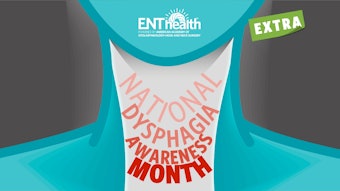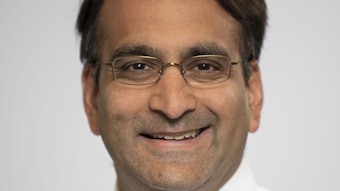Cochlear Migraine: Exploring Migraine’s Impact on the Auditory System
Cochlear migraine represents a unique and often overlooked disorder that manifests as recurrent episodes of auditory symptoms with migraine features.
Hamid R. Djalilian, MD*, Daniel Keum, BS, Yalda Yazdani, MD, Mehdi Abouzari, MD, PhD, and Euyhyun Park, MD, PhD
*Author disclosures follow at the end of this article.
Cochlear migraine, first described in 2018, represents the effects of migraine on the auditory system. This condition is distinct from the more widely recognized vestibular migraine, which primarily affects the vestibular system.1,2 Cochlear migraine manifests as recurrent episodes of auditory symptoms associated with migraine features. These symptoms are most commonly recurrent or fluctuating unilateral low frequency hearing loss without vertigo or mild dizziness that does not meet the criteria for vestibular migraine or Ménière’s disease along with aural fullness in the affected ear.
Clinical Features and Presentation of Cochlear Migraine
Additional minor clinical features include aura before hearing loss, concomitant tinnitus, family history of migraine-related disorders, unilateral neck stiffness (most commonly ipsilateral to the ear with symptoms), photophobia or phonophobia, motion sickness, visual motion intolerance, and sensitivity to atmospheric pressure changes.2,3
The hallmark of cochlear migraine is the presence of auditory symptoms that occur in association with migraine or migraine-like symptoms in the absence of headaches. Importantly, these auditory manifestations often occur without the typical migraine headache at the same time or in the past.4 As such, a diagnosis of classic migraine is not necessary for the diagnosis of cochlear migraine. We consider cochlear migraine a subcategory of otologic migraine, which includes all the manifestations of migraine in the ear (Figure 1).
 Figure 1. Different manifestations of migraine in the ear (otologic migraine). Ménière’s disease is at the intersection of cochlear and vestibular migraine, sometimes termed “cochleovestibular migraine.”
Figure 1. Different manifestations of migraine in the ear (otologic migraine). Ménière’s disease is at the intersection of cochlear and vestibular migraine, sometimes termed “cochleovestibular migraine.”
Pathophysiological Mechanisms
Trigeminal Nerve Involvement
The exact pathophysiological mechanisms underlying cochlear migraine are not fully known, but several theories have been proposed (Figure 2). What is known is that the ophthalmic branch (V1) of the trigeminal nerve extensively innervates the spiral modiolar artery and the stria vascularis.5,6 In addition, stimulation of V1 leads to fluid extravasation within the cochlea within one hour.7 Therefore, activation of V1, can lead to changes in the cochlear blood supply and resultant changes within the cochlea with more fluid in the cochlea (i.e., hydrops). Fluid dysregulation in the cochlea and a state of hydrops affects the trigeminal innervation of the cochlea.8
Cortical Spreading Depression and Neurogenic Inflammation
Migraine is caused by cortical spreading depression, a phenomenon typically associated with migraine aura, which might affect auditory processing areas in the brain.9 The cortical spreading depression causes activation of the trigeminal nerve that can lead to many downstream effects. The trigeminal nerve, in turn, secretes inflammatory neuropeptides, such as calcitonin gene-related peptide (CGRP) and substance P.10
The trigeminal nerve innervates all the intracranial blood vessels as well as the dura in addition to other structures of the head and neck. The secretion of CGRP and other compounds leads to neurogenic inflammation and increased blood flow in the affected blood vessels.11 Finally, trigeminal nerve activation can lead to a state of central sensitivity, where the brain can amplify sensory stimuli, thus causing many other symptoms in patients.
Mechanisms of Auditory Symptoms
Hearing Loss Mechanisms
According to new understanding of the role of migraine on the ear, the most likely etiology of fluctuating hearing loss is recurrent changes to cochlear blood flow due to trigeminal nerve activation.12 Increased tinnitus and hyperacusis are due to the central sensitization that occurs as a result of the trigeminal nerve activation and neuroinflammatory process it causes.12
Tinnitus, Hyperacusis, and Aural Fullness
Sometimes, hyperacusis presents with pulsatile tinnitus as patients tend to hear internal sounds at a louder level than external sounds. In some patients, sudden brief unilateral tapering tinnitus (tinnitus lasting less than one minute)13 likely occurs from a temporary decrease in hearing caused by change in cochlear blood flow. However, the fluctuation or change in baseline constant tinnitus is due to central sensitization.12 Aural fullness in patients with cochlear migraine is most likely due to activation of the tensor tympani and sustained contraction.14,15
 Figure 2. Central and peripheral mechanisms involved in the pathophysiology of otologic migraine.
Figure 2. Central and peripheral mechanisms involved in the pathophysiology of otologic migraine.
Proposed Diagnostic Criteria
Lai et al.16 outlined “hypothetical” diagnostic criteria for diagnosing cochlear migraine. These criteria are:
- at least two episodes of migraine with cochlear symptoms with or without recovery
- current or previous history of migraine with or without aura according to the International Classification of Headache Disorders-3 (ICHD-3)
- one or more migraine features with at least 50% of the cochlear episodes
- no current or previous history of vestibular symptoms
- not better accounted for by another cochlear or ICHD-3 diagnosis
Based on these criteria, they have defined four types of cochlear migraine:
Type 1: Unilateral fluctuating sensorineural hearing loss (SNHL) with or without tinnitus—generally low frequency SNHL
Type 2: Repeated idiopathic sudden SNHL with or without tinnitus, with good recovery
Type 3: Sudden SNHL with or without tinnitus, which deteriorates with time
Type 4: Unilateral fluctuating tinnitus with or without aural fullness, otalgia or mild SNHL16
Our Clinical Observations
The current authors have found that nearly half of our patients with cochlear symptoms (fluctuating hearing loss, sudden SNHL, or fluctuating tinnitus) do not have a history of migraine headaches. This can lead to an underdiagnosis of this condition. We have found that a vast majority of cases with fluctuating hearing loss, recurrent sudden hearing loss, fluctuating tinnitus, loud bothersome tinnitus, change in the baseline level of tinnitus (quiet tinnitus becoming louder after a certain event), intermittent tinnitus, and hyperacusis to all be part of the family of cochlear migraine. Such patients overwhelmingly respond to migraine preventative diet and lifestyle changes as well as prophylactic medical treatment.17,18
Treatment of Cochlear Migraine
Acute Management
The management of cochlear migraine typically involves a multifaceted approach. Acute management of episodes may include migraine-specific medications such as oral steroids that are used as a migraine abortive.19
Combined Therapy for Sudden Hearing Loss
In the case of sudden hearing loss, short-term use of oral and intratympanic steroids has been shown to improve hearing outcome. It is possible that the effect of intratympanic steroids is due to its effect on cochlear blood flow.20 When traditional therapy for sudden hearing loss (oral and intratympanic steroids) has been combined with migraine prophylactic medications, improved outcomes have been seen, especially in the low frequencies.21
In a previous work by our group, we found that even in patients with long-term sudden hearing loss (>3 months in duration), 33% of patients with non-usable hearing (<50% word discrimination) had a significant enough improvement with this combination of therapies to improve to usable hearing levels (>50% word discrimination).22 On average, posttreatment word discrimination and speech-recognition threshold (SRT) were significantly improved (45 ± 28% vs. 70 ± 28% and 57 ± 18 dB vs. 50 ± 16 dB, respectively, both p < 0.01).
Interestingly, we observed ≥15% improvement in Word Recognition Score (WRS) and ≥10 dB improvement in SRT in 13 (68%) and 8 (40%) patients, respectively. Of the 11 patients who presented with initial <50% word discrimination, eight (73%) had improved posttreatment >50% WRS with an average improvement of 39 ± 9%. We found that patients with active migraine-related symptoms, e.g., headaches, neck stiffness, or aural fullness, had better outcomes.22 We routinely use migraine prophylaxis for patients with fluctuating hearing loss and have had great success in controlling fluctuations with this regimen.
Diet and Lifestyle Modifications
Lifestyle modifications to avoid migraine triggers (Table 1) and stress management techniques are critical components in the long-term management of cochlear migraine.23 We also recommend an in-person or internet-based cognitive behavioral therapy (iCBT) directed toward migraine and tinnitus for our tinnitus patients.24
Therapeutic Outcomes for Tinnitus
We have found that the combination of sound therapy and iCBT for these patients led to significantly higher improvements than control patients in their Tinnitus Functional Index (16.7 ± 14.9 vs. 1.9 ± 10.8, p < 0.001), and generalized anxiety disorders-7 (GAD-7) score of 1.1 ± 3.6 vs. -0.9 ± 3.3, p = 0.009. For patients with persistent auditory symptoms, additional interventions such as generic or customized sound therapy for tinnitus25 or hearing aids for significant hearing loss may be necessary. We have found that health coaches are valuable in keeping patients on task with improvement in stress reaction, sleep optimization, and dietary modifications.26
Table 1. Common Migraine Triggers

Future Directions and Clinical Implications
Research Priorities
Cochlear migraine represents a unique and often overlooked subtype of migraine that specifically affects the auditory system. Its recognition as a distinct entity is crucial for appropriate diagnosis and management as many patients with cochlear symptoms (e.g., tinnitus and hyperacusis) are untreated or undertreated and can be improved with medical therapy. As our understanding of cochlear migraine continues to evolve, several important research directions emerge.
There is a pressing need to develop specific diagnostic criteria for this condition, which would facilitate more accurate diagnosis and targeted treatment. In addition, a neurophysiologic or laboratory test can help facilitate easier diagnosis. Animal model development can help facilitate better understanding of and treatment development for this condition.
Implications for Otolaryngologists
For otolaryngologists-head and neck surgeons, awareness of cochlear migraine is essential when evaluating patients with recurrent auditory symptoms, particularly those with recurrent sudden hearing loss, fluctuating hearing loss, certain subtypes of tinnitus (Figure 1), and hyperacusis. There needs to be a paradigm shift away from considering these symptoms to be caused by an otogenic cause toward a neurovascular and central sensitivity-related disorder.
The idea of neurovascular changes affecting the inner ear was first described in 1948 and 1949 by Jerome Hilger.27,28 It took nearly five decades for the basic science work to demonstrate the trigeminal innervation of the cochlear blood supply and stria vascularis,5 and that stimulation of cranial nerve V leads to fluid extravasation within the cochlea.7 It took another 10 to 20 years to better understand cochlear migraine and develop treatment algorithms that are effective in its treatment. We are in a new era of understanding many otologic disorders that were previously considered idiopathic.
Conclusion
Cochlear migraine, like migraine headaches and vestibular migraine, is a complex disorder that has multiple triggering factors such as stress, disrupted sleep, diet (dehydration, hunger, certain foods), hormonal changes, and overstimulation. Treatment of complex disorders generally requires a combination of trigger control (e.g., lifestyle and dietary changes) in addition to medical therapy.
Patient education on lifestyle changes, use of iCBT, health coaches, and becoming familiar with the treatment regimen will allow otolaryngologists to help these traditionally underserved patients. With better understanding and treatment of cochlear migraine, telling patients that nothing can be done for tinnitus and chronic oral steroid therapy for fluctuating hearing loss is no longer necessary.
The views expressed are solely those of the authors and may or may not be shared by the AAO-HNS. The AAO-HNS does not endorse specific products, services, or techniques.
Author Disclosures: Hamid Djalilian, MD, has equity interest in Eliava Technologies, Cactus Medical LLC, and NeuroMedCare. He is an inventor on intellectual property owned by the University of California related to hearing loss and tinnitus treatment. The other authors do not have relevant disclosures.
References
- Lai JT, Liu TC. Proposal for a New Diagnosis for Cochlear Migraine. JAMA Otolaryngol Head Neck Surg 2018;144(3):185-186.
- Lin HW, Djalilian HR. The role of migraine in hearing and balance symptoms. JAMA Otolaryngol Head Neck Surg 2018;144:717-718.
- Benjamin, T, Gillard, D, Abouzari, M, Djalilian, HR & Sharon, JD. Vestibular and auditory manifestations of migraine. Current Opinion in Neurology 2022;35:84-89.
- Calhoun AH, Weissman JD, Ford JH, Burch R. Vestibular migraine is more than just vertigo: A narrative review. Headache 2017;57(5):765-775.
- Vass Z, Shore SE, Nuttall AL, Jancsó G, Brechtelsbauer PB, Miller JM. Trigeminal ganglion innervation of the cochlea--a retrograde transport study. Neuroscience 1997;79(2):605-15.
- Vass Z, Shore SE, Nuttall AL, Miller JM. Direct evidence of trigeminal innervation of the cochlear blood vessels. Neuroscience 1998;84(2):559-67.
- Vass Z, Steyger PS, Hordichok AJ, Trune DR, Jancsó G, Nuttall AL. Capsaicin stimulation of the cochlea and electric stimulation of the trigeminal ganglion mediate vascular permeability in cochlear and vertebro-basilar arteries: a potential cause of inner ear dysfunction in headache. Neuroscience 2001;103(1):189-201.
- Vass Z, Shore SE, Nuttall AL, Miller JM. Endolymphatic hydrops reduces retrograde labeling of trigeminal innervation to the cochlea. Exp Neurol 1998;151(2):241-8.
- Charles A, Baca SM. Cortical spreading depression and migraine. Nature Reviews Neurology 2013;9(11):637-644.
- Wattiez AS, Sowers LP, Russo AF. Calcitonin gene-related peptide (CGRP): Role in migraine pathophysiology and therapeutic targeting. Expert Opin Ther Targets 2020;24(2):91-100.
- Hillerdal M, Andersson SE. The effects of calcitonin gene-related peptide (CGRP) on cochlear and mucosal blood flow in the albino rabbit. Hear Res 1991;52(2):321-328.
- Lee A, Abouzari M, Akbarpour M, Risbud A, Lin HW, Djalilian HR. A proposed association between subjective nonpulsatile tinnitus and migraine. World J Otorhinolaryngol Head Neck Surg 2022;9(2):107-114.
- Oron Y, Roth Y, Levine RA. Sudden brief unilateral tapering tinnitus: prevalence and properties. Otol Neurotol 2011;32(9):1409-14.
- Moshtaghi O, Ghavami Y, Mahboubi H, Sahyouni R, Haidar Y, Ziai K, Lin HW, Djalilian HR. Migraine-Related Aural Fullness: A Potential Clinical Entity. Otolaryngol Head Neck Surg 2018;158(1):100-102.
- Risbud A, Muhonen EG, Tsutsumi K, Martin EC, Abouzari M, Djalilian HR. Migraine Features in Patients With Isolated Aural Fullness and Proposal for a New Diagnosis. Otol Neurotol 2021;42(10):1580-1584.
- Lai JT, Liu TC, Hwang JH. Hypothetical criteria and types for cochlear migraine. Medicine (Baltimore) 2025;104(2):e41127.
- Abouzari M, Tawk K, Kim JK, Larson ED, Lin HW, Djalilian HR. Efficacy of nortriptyline-topiramate and verapamil-paroxetine in tinnitus management: a randomized placebo-controlled trial. Otolaryngol Head Neck Surg 2025;172(4):1348-1356.
- Abouzari M, Tan D, Sarna B, Ghavami Y, Goshtasbi K, Parker EM, Lin HW, Djalilian HR. Efficacy of Multi-Modal Migraine Prophylaxis Therapy on Hyperacusis Patients. Ann Otol Rhinol Laryngol 2020;129(5):421-427.
- Rozen TD. Migraine Headache: Immunosuppressant Therapy. Curr Treat Options Neurol 2002;4(5):395-401.
- Shirwany NA, Seidman MD, Tang W. Effect of transtympanic injection of steroids on cochlear blood flow, auditory sensitivity, and histology in the guinea pig. Am J Otol 1998;19(2):230-5.
- Abouzari M, Goshtasbi K, Chua JT, Tan D, Sarna B, Saber T, Lin HW, Djalilian HR. Adjuvant Migraine Medications in the Treatment of Sudden Sensorineural Hearing Loss. Laryngoscope 2021;131(1):E283-E288.
- Goshtasbi K, Chua JT, Risbud A, Sarna B, Jamshidi S, Abouzari M, Djalilian HR. Treatment of long-term sudden sensorineural hearing loss as an otologic migraine phenomenon. Otol Neurotol 2021;42(7):1001-1007.
- Frank M, Tawk K, Lee EJ, Kim JK, Al-Seraji A, Abouzari M, Djalilian HR. Efficacy of Nortriptyline and Migraine Lifestyle Modifications in Vestibular Migraine Management. Clin Otolaryngol 2025;50(1):62-67.
- Goshtasbi K, Tawk K, Khosravi P, Abouzari M†, Djalilian HR. Smartphone-based cognitive behavioral therapy and customized sound therapy for tinnitus: A randomized controlled trial. Ann Otol Rhinol Laryngol 2025;134(2):125-133.
- Mahboubi H, Haidar YM, Kiumehr S, Ziai K, Djalilian HR. Customized Versus Noncustomized Sound Therapy for Treatment of Tinnitus: A Randomized Crossover Clinical Trial. Ann Otol Rhinol Laryngol 2017;126(10):681-687.
- Djalilian HR. Can You Outsource Motivation? Leveraging health coaching to improve clinical outcomes. Psychology Today Online. Published March 2025. https://www.psychologytoday.com/us/blog/sound-mind/202503/can-you-outsource-motivation Accessed on April 8, 2025.
- Hilger J. Autonomic dysfunction in the inner ear. Minn Med 1948;31(4):419-24.
- Hilger JA. Autonomic dysfunction in the inner ear. Laryngoscope 1949;59(1):1-11.


















